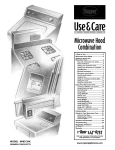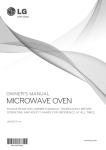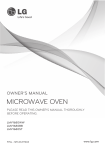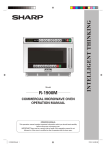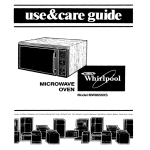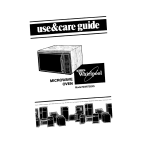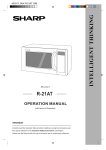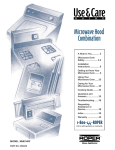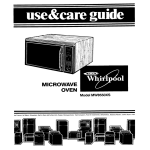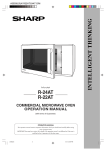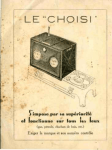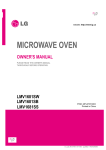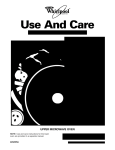Download Whirlpool MHE13XH User's Manual
Transcript
Microwave Hood Combination A Note to You............2 Microwave Oven Safety ........................3 Getting to Know Your Microwave Oven.......6 Using Your Microwave Oven.....11 Cooking Guide ........19 Caring for Your Microwave Oven.....20 Questions and Answers ..................23 Troubleshooting ......24 Requesting Assistance or Service ....................25 Warranty..................28 MODEL MHE13XH 3828W5A0993/4359930 A NOTE TO YOU Thank you for buying a ROPER appliance. ® Your ROPER appliance gives you all the functionality of name brand appliances at a value price. To ensure that you enjoy years of trouble-free operation, we developed this Use and Care Guide. It is full of valuable information about how to operate and maintain your appliance properly and safely. Please read it carefully. Also, complete and mail the Product Registration Card provided with your appliance. The card helps us notify you about any new information on your appliance. Please record your model’s information. Whenever you call to request service for your appliance, you need to know your complete model number and serial number. You can find this information on the model and serial number label/plate (see “Microwave oven features” in the “Getting to Know” section). Also, record the other information shown in the next column. Model Number __________________________________ Serial Number __________________________________ Purchase Date __________________________________ Dealer Name ____________________________________ Dealer Address __________________________________ Dealer Phone ____________________________________ Keep this book and the sales slip together in a safe place for future reference. It is important for you to save your sales receipt showing the date of purchase. Proof of purchase will assure you of in-warranty service. 2 MICROWAVE OVEN SAFETY Your safety and the safety of others is very important. We have provided many important safety messages in this manual and on your appliance. Always read and obey all safety messages. This is the safety alert symbol. This symbol alerts you to hazards that can kill or hurt you and others. All safety messages will be preceded by the safety alert symbol and the word “DANGER” or “WARNING.” These words mean: wDANGER You will be killed or seriously injured if you don’t follow instructions. wWARNING You can be killed or seriously injured if you don’t follow instructions. All safety messages will identify the hazard, tell you how to reduce the chance of injury, and tell you what can happen if the instructions are not followed. IMPORTANT SAFETY INSTRUCTIONS When using electrical appliances basic safety precautions should be followed, including the following: WARNING: To reduce the risk of burns, electric shock, fire, injury to persons, or exposure to excessive microwave energy: • Read all instructions before using the microwave oven. • Read and follow the specific “PRECAUTIONS TO AVOID POSSIBLE EXPOSURE TO EXCESSIVE MICROWAVE ENERGY” found in this section. • The microwave oven must be grounded. Connect only to properly grounded outlet. See “GROUNDING INSTRUCTIONS” found at the end of this section. • Install or locate the microwave oven only in accordance with the provided installation instructions. • Some products such as whole eggs in the shell and sealed containers – for example, closed glass jars – may explode and should not be heated in the microwave oven. • Use the microwave oven only for its intended use as described in this manual. Do not use corrosive chemicals or vapors in the microwave oven. This type of oven is specifically designed to heat, cook, or dry food. It is not designed for industrial or laboratory use. • As with any appliance, close supervision is necessary when used by children. • Do not operate the microwave oven if it has a damaged cord or plug, if it is not working properly, or if it has been damaged or dropped. • The microwave oven should be serviced only by qualified service personnel. Call an authorized service company for examination, repair, or adjustment. • See door surface cleaning instructions in the “Caring for Your Microwave Oven” section. • To reduce the risk of fire in the oven cavity: – Do not overcook food. Carefully attend the microwave oven if paper, plastic, or other combustible materials are placed inside the oven to facilitate cooking. – Remove wire twist-ties from paper or plastic bags before placing bags in oven. – If materials inside the oven should ignite, keep oven door closed, turn oven off, and disconnect the power cord, or shut off power at the fuse or circuit breaker panel. – Do not use the cavity for storage purposes. Do not leave paper products, cooking utensils, or food in the cavity when not in use. – SAVE THESE INSTRUCTIONS – 3 MICROWAVE OVEN SAFETY IMPORTANT SAFETY INSTRUCTIONS • Suitable for use above both gas and electric cooking equipment. • Intended to be used above ranges with maximum width of 36 inches (91 cm). • Clean Ventilating Hoods Frequently - Grease should not be allowed to accumulate on hood or filter. • When flaming foods under the hood, turn the fan off. The fan, if operating, may spread the flame. • Use care when cleaning the vent-hood filter. Corrosive cleaning agents, such as lye-based oven cleaners, may damage the filter. – SAVE THESE INSTRUCTIONS – PRECAUTIONS TO AVOID POSSIBLE EXPOSURE TO EXCESSIVE MICROWAVE ENERGY... (a) Do not attempt to operate this oven with the door open since open-door operation can result in harmful exposure to microwave energy. It is important not to defeat or tamper with the safety interlocks. (b) Do not place any object between the oven front face and the door or allow soil or cleaner residue to accumulate on sealing surfaces. 4 (c) Do not operate the oven if it is damaged. It is particularly important that the oven door close properly and that there is no damage to the: (1) Door (bent), (2) Hinges and latches (broken or loosened), (3) Door seals and sealing surfaces. (d) The oven should not be adjusted or repaired by anyone except properly qualified service personnel. MICROWAVE OVEN SAFETY ELECTRICAL REQUIREMENTS wWARNING Observe all governing codes and ordinances. A 120 Volt, 60 Hz, AC only, 20 amp fused electrical supply is required. (A time-delay fuse is recommended.) It is recommended that a separate circuit serving only this appliance be provided. Electrical Shock Hazard Plug into a grounded 3 prong outlet. Do not remove ground prong. Do not use an adapter. Do not use an extension cord. Failure to follow these instructions can result in death, fire, or electrical shock. GROUNDING INSTRUCTIONS For all cord connected appliances: The microwave oven must be grounded. In the event of an electrical short circuit, grounding reduces the risk of electric shock by providing an escape wire for the electric current. The microwave oven is equipped with a cord having a grounding wire with a grounding plug. The plug must be plugged into an outlet that is properly installed and grounded. WARNING – Improper use of the grounding can result in a risk of electric shock. Consult a qualified electrician or serviceman if the grounding instructions are not completely understood, or if doubt exists as to whether the microwave oven is properly grounded. Do not use an extension cord. If the power supply cord is too short, have a qualified electrician or serviceman install an outlet near the microwave oven. For a permanently connected appliance: The microwave oven must be connected to a grounded, metallic, permanent wiring system, or an equipment grounding conductor should be run with the circuit conductors and connected to the equipment grounding terminal or lead on the appliance. – SAVE THESE INSTRUCTIONS – 5 GETTING TO KNOW YOUR MICROWAVE OVEN This section discusses the concepts behind microwave cooking. It also shows you the basics you need to know to operate your microwave oven. Please read this information before you use your oven. HOW YOUR MICROWAVE OVEN TESTING YOUR DINNERWARE OR Microwave ovens are safe. Microwave energy is not hot. It causes food to make its own heat, and it’s this heat that cooks the food. Microwaves are like TV waves, radio waves, or light waves. You cannot see them, but you can see what they do. A magnetron in the microwave oven produces microwaves. The microwaves move into the oven where they contact food as it turns on the turntable. The glass turntable of your microwave oven lets microwaves pass through. Then they bounce off a metal floor, back through the glass turntable, and are absorbed by the food. Test dinnerware or cookware before using. To test a dish for safe use, put it into the oven with a cup (250 mL) of water beside it. Cook at 100% cook power for one minute. If the dish gets hot and water stays cool, do not use it. Some dishes (melamine, some ceramic dinnerware, etc.) absorb microwave energy, becoming too hot to handle and slowing cooking times. Cooking in metal containers not designed for microwave use could damage the oven, as could containers with hidden metal (twist-ties, foil lining, staples, metallic glaze or trim). WORKS Magnetron COOKWARE O• PERATING SAFETY PRECAUTIONS • • Oven cavity • Microwaves pass through most glass, paper, and plastics without heating them so food absorbs the energy. Microwaves bounce off metal containers so food does not absorb the energy. • RADIO INTERFERENCE • Using your microwave oven may cause interference to your radio, TV, or similar equipment. When there is interference, you can reduce it or remove it by: • Cleaning the door and sealing surfaces of the oven. • Adjusting the receiving antenna of the radio or television. • Moving the receiver away from the microwave oven. • Plugging the microwave oven into a different outlet so that the microwave oven and receiver are on different branch circuits. TESTING YOUR MICROWAVE OVEN To test the oven put about 1 cup (250 mL) of cold water in a glass container in the oven. Close the door. Make sure it latches. Cook at 100% power for 2 minutes. When the time is up, the water should be heated. 6 • • • Never lean on the door or allow a child to swing on it when the door is open. Use hot pads. Microwave energy does not heat containers, but the heat from the food can make the container hot. Do not use newspaper or other printed paper in the oven. Do not dry flowers, fruit, herbs, wood, paper, gourds, or clothes in the oven. Do not start a microwave oven when it is empty. Product life may be shortened. If you practice programming the oven, put a container of water in the oven. It is normal for the oven door to look wavy after the oven has been running for a while. Do not try to melt paraffin wax in the oven. Paraffin wax will not melt in a microwave oven because it allows microwaves to pass through it. Do not operate the microwave oven unless the glass turntable is securely in place and can rotate freely. The turntable can rotate in either direction. When you use a browning dish, the browning dish bottom must be at least 3⁄16 in (5 mm) above the turntable. Follow the directions supplied with the browning dish. Never cook or reheat a whole egg inside the shell. Steam buildup in whole eggs may cause them to burst, and possibly damage the oven. Slice hard-boiled eggs before heating. In rare cases, poached eggs have been known to explode. Cover poached eggs and allow a standing time of one minute before cutting into them. GETTING TO KNOW YOUR MICROWAVE OVEN • • • • Do not do canning of foods in the oven. Closed glass jars may explode, resulting in damage to the oven or possible personal injury. • Do not use the microwave oven to sterilize objects (baby bottles, etc.). It is difficult to maintain the high temperature required for safe sterilization. Stir any liquid several times during heating or reheating. Liquids heated in certain containers (especially containers shaped like cylinders) may become overheated. The liquid may splash out with a loud noise during or after heating or when adding ingredients (coffee granules, tea bags, etc.). This can harm the oven. Do not deep fry in the oven. Microwavable utensils are not suitable and it is difficult to maintain appropriate deep-frying temperatures. Do not overcook potatoes. At the end of the recommended cooking time, potatoes should be slightly firm because they will continue cooking during standing time. After microwaving, let potatoes stand for 5 minutes. They will finish cooking while standing. ELECTRICAL CONNECTION If your electric power line or outlet voltage is less than 110 volts, cooking times may be longer. Have a qualified electrician check your electrical system. MICROWAVE OVEN FEATURES 1 8 7 6 2 3 4 Your microwave oven is designed to make your cooking experience as enjoyable and productive as possible. To get you up and running quickly, the following is a list of the oven’s basic features: 1. Door Handle. Pull to open door. 2. Door Safety Lock System. The oven will not operate unless the door is securely closed. 3. Window with Metal Shield. Shield prevents microwaves from escaping. It is designed as a screen to allow you to view food as it cooks. 4. Filter. 5. Cooktop/Countertop Light. Turn on to light your cooktop or countertop or turn on as a night light. 5 4 6. Fan and Cooktop Light Switches. 7. Control Panel. Touch the pads on this panel to perform all functions. 8. Vent Grille. 9. Cooking Guide. Use as a quick reference for Cook and Defrost settings. 10. Glass Turntable. The turntable turns food as it cooks for more even cooking. It must be in the oven during operation for best cooking results. 11. Model and Serial Number Plate. 7 GETTING TO KNOW YOUR MICROWAVE OVEN CONTROL PANEL FEATURES Your microwave oven control panel lets you select a desired cooking function quickly and easily. The following is a list of all the Command and Number pads located on the control panel. 1 2 4 3 6 5 7 8 18 1. Display. The display includes a clock and indicators to tell you time of day, cooking time settings, and cooking functions selected. 2. REHEAT. Touch this pad to reheat food from 5 preset categories. 3. DEFROST. Touch this pad followed by Number pads to thaw frozen food by weight. 4. COOK. Touch this pad to cook common microwaveprepared foods without needing to program times and cook powers. 5. POPCORN. Touch this pad 1 to 3 times to pop a bag of popcorn in any of three sizes. 6. BEVERAGE. Touch this pad 1 to 2 times to reheat a beverage. 7. BAKED POTATO. Touch this pad 1 to 4 times to bake potatoes. 8 8. COOK TIME. Touch this pad followed by Number pads to set a cooking time. 9. COOK POWER. Touch this pad after the cook time has been set, followed by a Number pad to set the amount of microwave energy released to cook the food. The higher the number, the higher the microwave power or “cooking speed.” 10. ADD 1 MINUTE. Touch this pad to cook for 1 minute, at 100% cook power, or to add an extra minute, at the set cook power to your cooking cycle. 11. Number Pads. Touch Number pads to enter cooking times, cook powers, temperatures, quantities, weights, or food categories. 12. CLOCK. Touch this pad to enter the correct time of day. 13. TIMER SET. Touch this pad to set the Minute Timer. GETTING TO KNOW YOUR MICROWAVE OVEN 14. TIMER OFF. Touch this pad to cancel the Minute Timer. 15. START/ENTER. Touch this pad to start a function. If you open the door after the oven begins to cook, touch START/ENTER again to restart oven. 16. OFF/CANCEL. Touch this pad to erase an incorrect command, cancel a program during cooking, or to clear the display. 17. LIGHT. Touch this pad to turn on the cooktop/countertop light. 18. FAN. Touch this pad to turn the fan on or off. NOTES: • If you have entered all settings for a function but do not touch START/ENTER within 5 seconds, the START indicator light will flash. • If you open the door while the oven is on and then shut the door, the START indicator light will flash. Touch START/ENTER to restart the oven. • If you choose a function but do not press another Command pad within 1 minute, the display returns to the time of day and you have to start over. Audible signals Audible signals are available to guide you when setting and using your oven: • A programming tone will sound each time you touch a pad. • One long tone signals the end of a Minute Timer countdown. • Four tones signal the end of a cooking cycle. • Two tones sound once every minute after an Endof-Cooking signal as a reminder if food has not been removed from oven. • Three tones sound if you have made an incorrect entry. To disable all audible signals: • Touch and hold Number pad 1 for 4 seconds to disable all programming tones. If you do not want to continue cooking: • Close the door and the light goes off. OR • Touch OFF/CANCEL. Using the Child Lock The Child Lock locks the control panel so children cannot use the microwave oven when you do not want them to. To lock the control panel: Touch and hold START/ENTER for 4 seconds. Three tones, followed by 2 tones, will sound and “LOC” will appear on the display. To unlock the control panel: Touch and hold START/ENTER for 4 seconds. Two tones will sound and “LOC” will be cleared from the display. Using the Demo/Learning feature You can see your microwave oven’s functions without turning the oven on. Note: This feature can only be used when the microwave oven is first connected to power. You cannot use the Demo/Learning feature after a Command pad has been touched. To set the Demo/Learning feature: 1. Open the door and keep it open. 2. Touch and hold Number pad 0 for 4 seconds. Three tones, followed by two tones, will sound. 3. Release Number pad 0. 4. Shut the door to start the Demo/Learning feature. To cancel the Demo/Learning feature: Touch OFF/CANCEL. To turn all signals back on: Repeat step under “To disable all audible signals” above. NOTE: Three tones, followed by two tones, will sound when audible signals are turned on or off. The three tones will be omitted if all tones are disabled. Interrupting cooking You can stop the oven during a cycle by opening the door. The oven stops heating and the fan stops, but the light stays on. To restart cooking, close the door and touch START/ENTER. 9 GETTING TO KNOW YOUR MICROWAVE OVEN USING THE FAN The pad on the bottom right of the control panel controls the 2-speed Fan. 1. Choose fan speed. Press FAN once for HIGH, twice for LOW. NOTE: If the temperature gets too hot around the microwave oven, the exhaust fan in the vent hood will automatically turn on at the LOW setting to protect the oven. It may stay on up to an hour to cool the oven. When this occurs, you cannot turn the fan off manually. 2. Turn fan off when desired. To cancel the Timed Fan function: NOTE: Touching TIMER OFF shuts off both the fan and timed function. Touching FAN shuts off just the fan. USING THE COOKTOP/COUNTERTOP LIGHT The pad on the bottom left of the control panel controls the cooktop/countertop light. Turn on/off light. Press LIGHT once for HIGH, twice for LOW (night), three times to turn off. Press FAN until it turns off. To set fan to run for a specific time: 1. Touch FAN. To set light to be on for a specific time: 1. Touch LIGHT. (once or twice) (once or twice) 2. Touch TIMER SET. Once, display will show “TIMER”. Twice, display will show “FAN”, then “HR : MN”. NOTES: • Be sure you have set a time of day with the Clock function before setting any Timer function. • If both the fan and light are operating and TIMER is touched twice, both the fan and light will be controlled by the timer. The display will alternate between “FAN” and “LIGHT” one time before “HR:MN” is displayed. 3. Set fan run time. Example to run the fan for 1 hour and 30 minutes: Touch “1 3 0” and display will show “1 : 30”. 4. Start Timed Fan Function. Touch “START/ENTER” or “TIMER SET” and display will show “F 1 : 30”. NOTE: The letter “F” indicates the Timed Fan feature has been selected. If both the Timed Fan and Light feature have been selected, an “H” (Hood) will be displayed. At end of time, the current time of day will show and no tones will sound. 2. Touch TIMER SET. Once, display will show “TIMER”. Twice, display will show “FAN”, then “HR : MN”. NOTES: • Be sure you have set a time of day with the Clock function before setting any Timer function. • If both the fan and light are operating and TIMER is touched twice, both the fan and light will be controlled by the timer. The display will alternate between “FAN” and “LIGHT” one time before “HR:MN” is displayed. 3. Set light on time. Example to turn light on for 1 hour and 30 minutes: Touch “1 3 0” and display will show “1 : 30”. 4. Start Timed Light function. Touch “START/ENTER” or “TIMER SET” and display will show “L 1 : 30”. NOTE: The letter “L” indicates the Timed Light feature has been selected. If both the Timed Light and Fan feature have been selected, an “H” (Hood) will be displayed. At end of time, the current time of day will show and no tones will sound. To cancel the Timed Light function: NOTE: Touching TIMER OFF shuts off both the light and timed function. Touching LIGHT shuts off just the light. 10 USING YOUR MICROWAVE OVEN SETTING THE CLOCK When your microwave oven is first plugged in or after a power failure, the display will show “88:88.” For the first 30 seconds after the power is on, you can set the clock time without touching CLOCK. After 30 seconds has gone by, you must follow the directions below to set the time. If a time of day is not set, “88:88” will show on the display until you touch CLOCK. NOTES: • You can only set the clock if the oven is not cooking food. • If you enter an incorrect time and touch CLOCK, three tones will sound. Enter the correct time. • If you touch OFF/CANCEL while setting the clock, the display will show the last time of day set or “:” if no time of day has been set. To set time: 1. Touch CLOCK. 2. Enter time of day. Example for 12:00: Touch “1 2 0 0”. Then touch CLOCK or START/ENTER. USING THE MINUTE TIMER You can use your microwave oven as a minute timer. Use the Minute Timer for timing up to 99 minutes, 99 seconds. NOTE: The oven can operate while the Minute Timer is in use. To see the Minute Timer while the oven is cooking, touch TIMER SET. To return the display to the cooking time countdown, touch TIMER SET again. 1. Touch TIMER SET. 2. Enter time to be counted down. Example for 1 minute, 30 seconds: Touch “1 3 0”. NOTE: If you enter more than 4 digits, 3 tones will sound. Touch START/ENTER to count down the 3digit time you have entered or touch TIMER OFF to clear the display. To start over, touch TIMER SET and re-enter desired time. 3. Start countdown. Touch START/ENTER or TIMER SET. NOTE: If you do not do this step within 3 seconds of doing Step 2, “START” will flash. You then have 1 minute to touch START/ENTER or TIMER SET before the display returns to time of day. At end of countdown: “End” will be displayed on the screen and one tone will sound. To cancel Minute Timer: During countdown: Touch TIMER OFF. After countdown: Touch OFF/CANCEL. USING YOUR MICROWAVE OVEN This section gives you instructions for operating each function. Please read these instructions carefully. 1. Put food in oven and close the door. 2. Set cooking time. Touch COOK TIME. Example for 7 minutes, 30 seconds: Touch “7 3 0”. 3. Set cook power. Touch COOK POWER, enter level 1-10. See “Cooking at different cook powers” for recommended cook powers. NOTE: This step is not necessary to cook at High Power. 4. Start oven. Touch START/ENTER. At end of cooking time: Display will show “END”. Changing instructions You can change the cooking time or cook power after cooking starts by repeating Steps 2 and/or 3 and 4. 11 USING YOUR MICROWAVE OVEN COOKING AT DIFFERENT COOK POWERS For best results, some recipes call for different cook powers. The lower the cook power, the slower the cooking. Each Number pad also stands for a different percentage of cook power. Many microwave cookbook recipes tell you by number, percent, or name which cook power to use. COOK POWER 100% of full power (automatic) NOTE: Refer to a reliable cookbook for cooking times. NAME WHEN TO USE IT High • Quick heating many convenience foods and foods with high water content, such as soups and beverages • Cooking small tender pieces of meat, ground meat, poultry pieces, fish fillets, and most vegetables 9=90% of full power 8=80% of full power 7=70% of full power The following chart gives the percentage of cook power each Number pad stands for, and the cook power name usually used. It also tells you when to use each cook power. Follow recipe or food package instructions if available. Medium-High • Heating cream soups • Heating rice, pasta, or stirrable casseroles • Cooking and heating foods that need a cook power lower than high (for example, whole fish and meat loaf) or when food is cooking too fast • Reheating a single serving of food • Cooking sensitive foods such as cheese and egg 6=60% of full power dishes, pudding, and custards • Cooking non-stirrable casseroles, such as lasagna 5=50% of full power Medium 4=40% of full power 3=30% of full power Medium-Low, Defrost 2=20% of full power 1=10% of full power Low • Cooking ham, whole poultry, and pot roasts • Melting chocolate • Simmering stews • Heating pastries • Defrosting foods, such as bread, fish, meats, poultry, and precooked foods • Softening butter, cheese, and ice cream • Keeping food warm • Taking chill out of fruit NOTE: Once cook time has been entered you can also use the COOK POWER pad as a second Minute Timer by entering “0” for the cook power. The oven will count down the cooking time you set without cooking. 12 USING YOUR MICROWAVE OVEN COOKING WITH MORE THAN ONE COOK CYCLE For best results, some recipes call for one cook power for a certain length of time, and another cook power for another length of time. Your oven can be set to change from one to another automatically, for up to two cycles. 1. Put food in oven and close the door. 2. Set cooking time for first cycle. Touch COOK TIME and the desired amount of time. Refer to the following chart for quantities: NUMBER OF CUPS/ITEMS CATEGORY Casserole 1, 2, 3, 4 cups (250, 500, 750, 1000 mL) Bacon 2, 4, 6, 8 slices Rice 0.5, 1, 1.5, 2 cups (125, 250, 375, 500 mL) NOTE: See “Microwave cooking chart” in the “Cooking Guide” section for cooking with cook power and cooking time. 1. Put food in oven and close the door. 3. Set cook power for first cycle. Touch COOK POWER and desired power level for first cycle. 4. Repeat Steps 2 and 3 to set cooking time and cook power for the second cycle. 5. Start oven. Touch START/ENTER. After the first cycle is over, the next cycle will count down. At end of cooking time: The display will show “END”. Changing instructions 2. Choose COOK. Example for Casserole: Touch COOK, display will show “CSRLE”. After 4 seconds: Display will show “1 CUP”. 3. Increase quantity to 2 cups (500 mL) (within 3 seconds). While display shows “1 CUP”, you may increase the quantity to 2-4 cups (500-1000 mL) by pressing cook repeatedly. At end of cooking time: Display will show “END”. USING DEFROST You can change times or cook powers for a cycle any time after that cycle starts by repeating Steps 2 and/or 3 and 4. Your microwave oven automatically defrosts a variety of common meats at preset cook powers for preset times. The 3-stage defrost cycle is programmed for meat, poultry, and fish. USING COOK To use DEFROST: 1. Touch DEFROST once for meat, twice for poultry, or three times for fish. 2. Wait 4 seconds. 3. Enter the weight using the Number pads. 4. Touch START/ENTER. After approximately one-third and two-thirds of the defrost cycle, the oven will stop and prompt you to turn the food over. Cooking with COOK lets you heat common microwaveprepared foods without needing to program times and cook powers. COOK has preset times and cook powers for 3 food categories: Casserole, Bacon, and Rice. To use COOK: 1. Touch COOK once for Casserole, twice for Bacon, or three times for Rice. 2. Wait 4 seconds. 3. Touch COOK again to increase the number of cups/items. 1. Put frozen food in oven and close the door. 13 USING YOUR MICROWAVE OVEN NOTES: • Loosen or remove any packaging, or covering on food. • See the “Defrost chart” later in the “Using Your Microwave Oven” section for defrosting directions for each food. • To defrost items not listed in “Defrost chart” use 30% cook power. Refer to a reliable cookbook for defrosting information. Refer to the following chart to choose a category: 4. Start oven. Touch START/ENTER. 5. After a third of the cook time is over, display will prompt you to turn over food. Open door, turn over food, and shield any warm portions. CATEGORY Touch Defrost WEIGHT Meat once 0.1 - 9.9 lbs (45.4 g - 4.49 kg) Poultry twice 0.1 - 9.9 lbs (45.4 g - 4.49 kg) 6. Close the door. Fish three times 0.1 - 9.9 lbs (45.4 g - 4.49 kg) 7. Restart oven. 2. Choose DEFROST. Example for meat: Touch DEFROST, once for meat, twice for poultry, three times for fish. After 4 seconds, the display will prompt you to enter weight. 3. Enter food’s weight (in pounds and tenths of a pound). Example for 1.2 lbs (.54 kg): NOTES: • For converting fractions of a pound to decimals, see “Weight conversion chart” later in this section. • If you enter an incorrect weight, touch DEFROST again and enter the correct weight. 14 NOTE: If you do not open the door within 2 minutes, the display will resume the countdown. Touch START/ENTER. 8. After two-thirds of the cook time is over, display will prompt you to turn food over. Repeat steps 5, 6, and 7. At end of defrosting time: The display will show “END”. USING YOUR MICROWAVE OVEN DEFROST CHART FOOD AT PAUSE SPECIAL INSTRUCTIONS Meat of irregular shape and large, fatty cuts of meat should have the narrow or fatty areas shielded with foil at the beginning of a defrost cycle. Beef Ground Beef, Bulk Remove thawed portions with fork. Turn over. Return remainder to oven. Do not defrost less than 1⁄4 lb (113 g). Ground Beef, Patties Separate and rearrange. Do not defrost less than two 4 oz (113 g) patties. Round Steak, Tenderloin Steak, Pot Roast, Chuck Roast, Rib Roast, Rump Roast Stew Beef Turn over. Cover warm areas with aluminum foil. Place on a microwavable roasting rack. Remove thawed portions with fork. Separate remainder. Return remainder to oven. Place on a microwavable roasting rack. Remove thawed portions with fork. Return remainder to oven. Separate and rearrange. Place in a microwavable baking dish. Separate and rearrange. Place on a microwavable roasting rack. Spareribs, Loin Roast, (Boneless) Turn over. Cover warm areas with aluminum foil. Place on a microwavable roasting rack. Sausage, Bulk Remove thawed portions with fork. Turn over. Return remainder to oven. Place in a microwaveable baking dish. Fillets Turn over. Separate fillets when partially thawed. Place in a microwavable baking dish. Carefully separate fillets under cold water. Steaks Separate and rearrange. Place in a microwavable baking dish. Run cold water over to finish defrosting. Whole Turn over. Place in a microwavable baking dish. Cover head and tail with foil; do not let foil touch sides of microwave oven. Finish defrosting by immersing in cold water. Break apart, turn over, and rearrange. Place in a microwavable baking dish. Lamb Cubes for Stew Chops (1 in [2.54 cm] thick) Pork Chops (1⁄2 in [1.27 cm] thick), Hot Dogs, Sausage, Links Place on a microwavable roasting rack. Fish Shellfish Crabmeat, Lobster Tails, Shrimp, Scallops 15 USING YOUR MICROWAVE OVEN DEFROST CHART (CONT.) AT PAUSE SPECIAL INSTRUCTIONS Whole (up to 41⁄2 lbs [2.04 kg]) Turn over (finish defrosting breast-side down). Cover warm areas with aluminum foil. Place chicken breast-side up on a microwavable roasting rack. Finish defrosting by immersing in cold water. Remove giblets when chicken is partially defrosted. Cut Up Separate pieces and rearrange. Place on a microwavable roasting rack. Turn over. Cover warm areas with aluminum foil. Finish defrosting by immersing in cold water. Turn over. Cover warm areas with aluminum foil. Place on a microwavable roasting rack. Finish defrosting by immersing in cold water. Turn over. Cover warm areas with aluminum foil. Place on a microwavable roasting rack. Finish defrosting by immersing in cold water. FOOD Chicken Cornish Hens Whole Turkey Breast (under 6 lbs [2.72 kg]) D• EFROSTING TIPS When using DEFROST, the weight to be entered is the net weight in pounds and tenths of pounds (the weight of the food minus the container). • Before starting, make sure you have removed any of the metal twist-ties which often come with frozen food bags, and replace them with strings or elastic bands. • Open containers such as cartons before they are placed in the oven. • Always slit or pierce plastic pouches or packaging. • If food is foil wrapped, remove foil and place it in a suitable container. • Slit the skins, if any, of frozen food such as sausage. • Bend plastic pouches of food to ensure even defrosting. • Always underestimate defrosting time. If defrosted food is still icy in the center, return it to the microwave oven for more defrosting. Weight conversion chart You are probably used to food weights as being in pounds and ounces that are fractions of a pound (for example, 4 ounces equals 1⁄4 pound). However, in order to enter food weight in DEFROST, you must specify pounds and tenths of a pound. If the weight on the food package is in fractions of a pound, you can use the following chart to convert the weight to decimals. 16 • The length of defrosting time varies according to how solidly the food is frozen. • The shape of the package affects how quickly food will defrost. Shallow packages will defrost more quickly than a deep block. • As food begins to defrost, separate the pieces. Separated pieces defrost more easily. • Use small pieces of aluminum foil to shield parts of food such as chicken wings, leg tips, fish tails, or areas that start to get warm. Make sure the foil does not touch the sides, top, or bottom of the oven. The foil can damage the oven lining. • For better results, let food stand after defrosting. (For more information on standing time, see “Microwave cooking tips” in the “Cooking Guide” section.) • Turn over food during defrosting or standing time. Break apart and remove food as required. Equivalent Weight OUNCES Metric (g) 1.6 3.2 4.0 4.8 6.4 8.0 9.6 11.2 12.0 12.8 14.4 16.0 45.4 90.7 113.4 136.1 181.4 226.8 272.2 317.5 340.2 362.9 408.2 453.6 DECIMAL WEIGHT .10 .20 .25 .30 .40 .50 .60 .70 .75 .80 .90 1.00 One-Quarter Pound One-Half Pound Three-Quarters Pound One Pound USING YOUR MICROWAVE OVEN USING REHEAT USING BEVERAGE You can reheat food by choosing a category and quantity. REHEAT has preset times and cook powers for five categories: Pizza, Plate, Soup/Sauce, Casserole, and Baked Goods. NOTE: If you want to change the heating time after choosing BEVERAGE, see the “Adding or subtracting cook time” section. Refer to the following chart for quantities: CATEGORY NUMBER OF CUPS/ITEMS Pizza (refrigerated) 1 to 3 slices, 5 oz (142 g) each Plate (refrigerated) 1 to 2 servings Soup/Sauce (room temperature) 1 to 4 cups (250-1000 mL) Casserole (refrigerated) 1 to 4 cups (250-1000 mL) Baked Goods (room temperature) 1 to 4 items, 2 oz (57 g) each NOTE: See the “Reheating chart” in the “Cooking Guide” section for reheating with cook power and cooking time. 1. Put food in oven and close the door. 2. Touch REHEAT. Once for Pizza, twice for Plate, three times for Soup/Sauce, four times for Casserole, and five times for Baked Goods. After 4 seconds: The display will prompt you to enter the quantity. 3. Increase to 2 servings (within 3 seconds of step 2). Touch REHEAT to cycle through quantity options. BEVERAGE lets you heat a beverage by touching just one pad. 1. Place cup of beverage in oven and close the door. 2. Touch BEVERAGE. once for 8 oz (227 g), twice for 16 oz (454 g) In 3 seconds, the display will start counting down. At end of heating time: The display will show “END”. USING BAKED POTATO BAKED POTATO lets you cook potatoes (10 to 13 oz [283-369 g] each) by touching just one pad. With the preset times and cook powers, all you do is touch BAKED POTATO (1 to 4 times) to select the desired number of potatoes (1 to 4). Your microwave oven does the rest. 1. Place potatoes in oven and close the door. NOTES: • Before baking, pierce potato with fork several times. • After baking, let stand for 5 minutes. 2. Touch BAKED POTATO. 1-4 times for 1-4 potatoes After 3 seconds: The display will show remaining time. At end of cooking time: The display will show “END”. At end of heating time: The display will show “END”. 17 USING YOUR MICROWAVE OVEN USING POPCORN You can pop commercially packaged microwave popcorn by touching just one pad. The number of times you touch this pad determines which size of popcorn your oven will pop. For best results: • Pop only one package at a time. • If you are using a microwave popcorn popper, follow the manufacturer’s instructions. • Cooking performance may vary with brand and fat content. Try several brands to decide which gives best popping results. • Use fresh bags of popcorn. 1. Place the bag in the center of the turntable and close the door. To correctly set your microwave oven, follow this chart: Bag Size –ounces Touch POPCORN 3.50 oz (100 g) 3.00 oz (85 g) 1.75 oz (50 g) once twice three times NOTE: If you want to shorten or lengthen the cooking time after choosing POPCORN, see “Adding or subtracting cook time” at the end of the “Using Your Microwave Oven” section. 2. Touch POPCORN 1-3 times to cycle through popcorn bag sizes (3.5, 3.0, 1.75 oz [100, 85, 50 g]) After 3 seconds, oven starts popping popcorn: Every 10 seconds the display will alternate between “POP-” and “CORN” and then show the time remaining. At end of popping time: The display will show “END”. USING ADD 1 MINUTE ADD 1 MINUTE lets you cook food for 1 minute at 100% cook power or add an extra minute to your cook time cycle. You can also use it to extend cook time cycles in multiples of 1 minute, up to 99 minutes. NOTES: • To extend cook time cycles in multiples of 1 minute, touch ADD 1 MINUTE repeatedly during cooking. • After closing the door, you can enter ADD 1 MINUTE after touching START/ENTER. • If you touch ADD 1 MINUTE during cooking, the oven will cook at the currently selected cook power. If you touch ADD 1 MINUTE after cooking is over, the oven will cook at 100% cook power. • You can use ADD 1 MINUTE only for the cook time function. 1. Make sure food is in oven. 2. Touch ADD 1 MINUTE. Each time you press ADD 1 MINUTE, the time is increased by one minute. ADDING OR SUBTRACTING COOK TIME If a preset cook time is too long or too short, you can increase or decrease the cook time by 10% after choosing the function. You can only increase or decrease cook time before cooking starts. To increase cook time by 10%: TOUCH YOU SEE COOK To decrease cook time by 10%: TOUCH YOU SEE COOK To reset to the original cook time: TOUCH YOU SEE COOK 18 COOKING GUIDE COOKING GUIDE MICROWAVE COOKING TIPS For the best cooking results • Always cook food for the shortest cooking time recommended. • Stir, turn over, or rearrange the food being cooked about halfway through the cooking time. This will help make sure the food is evenly cooked. • If you do not have a cover for a dish, use wax paper, or microwave-approved paper towels or plastic wrap. Remember to turn back a corner of the plastic wrap to vent steam during cooking. Amount of food • If you increase or decrease the amount of food you prepare, the time it takes to cook that food will also change. For example, if you double a recipe, add a little more than half the original cooking time. Check for doneness and, if necessary, add more time in small increments. Starting temperature of food • The lower the temperature of the food being put into the microwave oven, the longer it takes to cook. Food at room temperature will be reheated more quickly than food at refrigerator temperature. Composition of food • Food with a lot of fat and sugar will be heated faster than food containing a lot of water. Fat and sugar will also reach a higher temperature than water in the cooking process. • The more dense the food, the longer it takes to heat. “Very dense” food like meat takes longer to reheat than lighter, more porous food like sponge cakes. Size and shape • Smaller pieces of food will cook faster than larger pieces and same-shaped pieces of food cook more evenly than irregularly shaped foods. • With unevenly shaped foods, the thinner parts will cook faster than the thicker areas. Place the thinner parts of chicken wings and legs in the center of the dish. Stirring, turning foods • Stirring and turning foods distributes heat quickly to the center of the dish and avoids overcooking at the outer edges of the food. Covering food Cover food to: reduce splattering, shorten cooking times, and retain food moisture. All coverings that allow microwaves to pass through are suitable. Releasing pressure in foods • Several foods (for example: baked potatoes, sausages, egg yolks, and some fruits) are tightly covered by a skin or membrane. This can cause the food to burst from steam building up in them during cooking. To relieve the pressure and to prevent bursting, pierce these foods before cooking with a fork, cocktail pick, or toothpick. Using standing time • Always allow food to stand for a while after cooking. Standing time after defrosting, cooking, or reheating always improves the result since the temperature will then be evenly distributed throughout the food. • The length of the standing time depends on the volume and density of the food. Larger, denser foods require a longer standing time. Arranging food For best results, distribute food evenly on the plate. You can do this in several ways: • If you are cooking several items of the same food, such as baked potatoes, place them in a ring pattern for uniform cooking. • When cooking foods of uneven shapes or thickness, such as chicken breasts, place the smaller or thinner area of the food towards the center of the dish where it will be heated last. • Layer thin slices of meat on top of each other. • When you cook or reheat whole fish, score the skin – this prevents cracking. Shield the tail and head of whole fish with small pieces of foil to prevent overcooking and ensure the foil does not touch the sides of the oven. • Do not let food or container touch the top or sides of the oven. This will prevent possible arcing. 19 CARING FOR YOUR MICROWAVE OVEN Using aluminum foil Metal containers should not be used in a microwave oven. There are, however, some exceptions. If you have purchased food which is prepackaged in an aluminum foil container, then refer to the instructions on the package. When using aluminum foil containers, cooking times may be longer because microwaves will only penetrate the top of the food. If you use aluminum containers without package instructions, follow these guidelines: • Place container in a glass bowl and add some water so that it covers the bottom of the container, not more than 1⁄4 in (6 mm) high. This ensures even heating of the container bottom. • • • • Always remove the lid to avoid damage to the oven. Do not use containers taller than 3⁄4 in (19 mm). Container must be half filled. To avoid arcing, there must be a minimum 1⁄4 in (6 mm) between the aluminum container and the walls of the oven and also between two aluminum containers. • Reheating food in aluminum foil containers usually takes up to double the time compared to reheating in plastic, glass, china, or paper containers. • Let food stand for 2 to 3 minutes after heating so that heat is spread evenly throughout container. CARING FOR YOUR MICROWAVE OVEN To make sure your microwave oven looks good and works well for a long time, you should maintain it properly. For proper care, please follow these instructions carefully. For interior surfaces: Wash often with warm, sudsy water and a sponge or soft cloth. Use only mild, nonabrasive soaps or a mild detergent. Be sure to keep the areas clean where the door and oven frame touch when closed. Wipe well with clean water. Over time, stains can occur on the surfaces as the result of food particles spattering during cooking. This is normal. For stubborn soil, boil a cup (250 mL) of water in the oven for 2 or 3 minutes. Steam will soften the soil. To get rid of odors inside the oven, boil a cup (250 mL) of water with lemon juice or vinegar. For exterior surfaces and control panel: Use a soft cloth with spray glass cleaner. Apply the spray glass cleaner to the soft cloth; do not spray directly on the oven. 20 NOTE: Abrasive cleansers, steel-wool pads, gritty wash cloths, some paper towels, etc., can damage the control panel and the interior and exterior oven surfaces. To clean turntable and turntable support, wash in mild, sudsy water; for heavily soiled areas use a mild cleanser and scouring sponge. The turntable and turntable support are dishwasher-safe. CARING FOR YOUR MICROWAVE OVEN CARING FOR THE FILTERS Charcoal filter: The grease filters should be removed and cleaned often, at least once a month. NOTE: If your microwave hood combination is installed to recirculate air, the charcoal filter (available from your authorized service company, Part No. 4359416) should be installed. The charcoal filter cannot be cleaned and should be replaced every 6 to 12 months. Grease filters: 1. Disconnect power or unplug microwave oven. 2. Remove the vent cover mounting screws. 3. Tip the cover forward, then lift out to remove. 1. Disconnect power or unplug microwave oven. 2. To remove grease filters, slide each filter to the side. Pull filters downward and push to the other side. The filter will drop out. 3. Soak grease filters in hot water and a mild detergent. Scrub and swish to remove embedded dirt and grease. Rinse well and shake to dry. Do not clean filters with ammonia, corrosive cleaning agents such as lye-based oven cleaners, or place them in a dishwasher. The filters will turn black or could be damaged. 4. To replace grease filters, slide filter in the frame slot on one side of the opening. Push filter upward and push to the other side to lock into place. 5. Reconnect power or plug in microwave oven. 4. Lift the back of the charcoal filter. Slide the filter straight out. 5. Slide a new charcoal filter into place. The filter should rest at the angle shown. 6. Slide the bottom of the vent cover into place. Push the top until it snaps into place. Replace the mounting screws. 7. Reconnect power or plug in microwave oven. NOTE: Do not operate the hood without the grease filters in place. 21 CARING FOR YOUR MICROWAVE OVEN REPLACING THE COOKTOP AND Bulb holder OVEN LIGHTS The cooktop light 1. Disconnect power or unplug microwave oven. 2. Remove the bulb cover mounting screws. 3. We recommend replacing bulb(s) with candelabrabase 40-watt bulb(s) available from your authorized service company, or by calling the Consumer Assistance Center at 1-616-923-7113. Make sure to have your model number when ordering. 4. Reconnect power or plug in microwave oven. 5. Lift up the bulb holder. 6. We recommend replacing the bulb with a candelabra-base 40-watt bulb available from your authorized service company, or by calling the Consumer Assistance Center at 1-616-923-7113. Make sure to have your model number when ordering. 7. Replace the bulb holder and mounting screw. The oven light 1. Disconnect power or unplug microwave oven. 2. Remove the vent cover mounting screws. 3. Tip the cover forward, then lift out to remove. 4. Remove bulb holder mounting screw. 22 8. Slide the top of the vent cover into place. Push the bottom until it snaps into place. Replace the mounting screws. 9. Reconnect power or plug in microwave oven. QUESTIONS AND ANSWERS QUESTIONS ANSWERS Can I operate my microwave oven without the turntable or turn the turntable over to hold a large dish? No. If you remove or turn over the turntable, you will get poor cooking results. Dishes used in your oven must fit on the turntable. Can I use a rack in my microwave oven so that I may reheat or cook on two levels at a time? You can use a rack only if the rack is supplied with your microwave oven. If you use a rack not supplied with the microwave oven, you can get poor cooking performance and/or arcing. Can I use either metal or aluminum pans in my microwave oven? You can use aluminum foil for shielding (use small, flat pieces), small skewers, and shallow foil trays (if tray is not taller than 3⁄4 in (19 mm) deep and half filled with food to absorb microwave energy). Never allow metal to touch walls or door. Is it normal for the turntable to turn in either direction? Yes. The turntable rotates clockwise or counterclockwise, depending on the rotation of the motor when the cooking cycle begins. Sometimes the door of my microwave oven appears wavy. Is this normal? This appearance is normal and does not affect the operation of your oven. What are the humming noises that I hear when my microwave oven is operating? You may hear the sound of the transformer when the magnetron tube cycles on. Why does the dish become hot when I microwave food in it? I thought that this should not happen. As the food becomes hot it will conduct the heat to the dish. Be prepared to use hot pads to remove food after cooking. What does “standing time” mean? “Standing time” means that food should be removed from the oven and covered for additional time to allow it to finish cooking. This frees the oven for other cooking. Why does steam come out of the air exhaust vent? Steam is normally produced during cooking. The microwave oven has been designed to vent this steam out the vents. Can I pop popcorn in my microwave oven? How do I get the best results? Yes. Pop packaged microwave popcorn following manufacturer’s guidelines or use the preset POPCORN pad. Do not use regular paper bags. Use the “listening test” by stopping the oven as soon as the popping slows to a “pop” every 1 or 2 seconds. Do not repop unpopped kernels. Do not pop popcorn in glass cookware. 23 TROUBLESHOOTING Most cooking problems often are caused by little things you can find and fix without tools of any kind. Check the lists below before calling for assistance or service. If you still need help, see the “Requesting Assistance or Service” section. IF MICROWAVE DOES NOT OPERATE, FIRST CHECK THE FOLLOWING: • • • Is the microwave plugged into a live outlet with the proper voltage? (See installation instructions.) Have you blown a household fuse or tripped a circuit breaker? Has the electric company experienced a power failure? OTHER POSSIBLE PROBLEMS AND THEIR CAUSES: Problem Cause The microwave oven will not run. • The door is not firmly closed and latched. • You did not touch START/ENTER. • You did not follow directions exactly. • An operation that was programmed earlier is still running. • You have not entered numbers after touching COOK TIME. • The electric supply to your home or wall outlets is low or lower than normal. Microwave cooking times seem too long. Your electric company can tell you if the line voltage is low. Your electrician or service technician can tell you if the outlet voltage is low. • The cook power is not at the recommended setting. • Larger amounts of food need longer cooking times. The turntable will not turn. • The turntable is not correctly in place. Make sure the turntable is correct-side The display shows a time counting down but the oven is not cooking. • The oven door is not closed completely. • You have set the controls as a kitchen timer. Touch OFF/CANCEL to You do not hear the Programming Tone. • The command is not correct. The fan seems to be running slower than usual. • The oven has been stored in a cold area. The fan will run slower until the oven The display is showing “88:88”. • There has been a power interruption. Reset the clock. up and is sitting securely on center shaft. • The support is not operating correctly. Remove turntable, check that the turntable support is properly in place, and restart oven. If turntable support does not move, call an authorized service technician for repair. Cooking without the turntable can give you poor results. cancel the Minute Timer. warms up to normal room temperature. If none of these items is causing your problem, see the “Requesting Assistance or Service” section on page 25. 24 REQUESTING ASSISTANCE OR SERVICE To avoid unnecessary service calls, please check the “Troubleshooting” section. It may save you the cost of a service call. If you still need help, follow the instructions below. IF YOU NEED ASSISTANCE OR SERVICE Call our Consumer Assistance Center at 1-616-923-7113. Our consultants are available to assist you. When calling: Please know the purchase date, and the complete model and serial number of your appliance (see the “A Note to You” section). This information will help us better respond to your request. • Accessory and repair parts sales • Specialized customer assistance (Spanish speak- ing, hearing impaired, limited vision, etc.) • Referrals to local dealers, service companies, and repair parts distributors To locate a designated servicer in your area, you can also look in your telephone directory Yellow Pages. Our consultants provide assistance with: • Features and specifications on our full line of appliances • Installation information • Use and maintenance procedures FOR FURTHER ASSISTANCE If you need further assistance, you can write to us with any questions or concerns at: Roper Brand Home Appliances Consumer Assistance Center c/o Correspondence Dept. 2000 North M-63 Benton Harbor, MI 49022-2692 Please include a daytime phone number in your correspondence. 25 WARRANTY ROPER MICROWAVE OVEN ® LENGTH OF WARRANTY WE WILL PAY FOR FULL ONE-YEAR WARRANTY FROM DATE OF PURCHASE FSP ® replacement parts and repair labor to correct defects in materials or workmanship. Service must be provided by a designated Roper service company. LIMITED FOUR-YEAR WARRANTY SECOND THROUGH FIFTH YEAR FROM DATE OF PURCHASE FSP replacement magnetron tube on microwave ovens if defective in materials or workmanship. WE WILL NOT PAY FOR A. Service calls to: 1. Correct the installation of your microwave oven. 2. Instruct you how to use your microwave oven. 3. Replace house fuses or correct house wiring. 4. Replace owner-accessible light bulbs. B. Repairs when your microwave oven is used in other than normal, single-family household use. C. Pickup and delivery. Your microwave oven is designed to be repaired in the home. D. Damage to your microwave oven caused by accident, misuse, fire, flood, acts of God, or use of products not approved by us. E. Any labor costs during limited warranty. F. Repairs to parts or systems resulting from unauthorized modifications made to the appliance. 10/98 This Roper appliance is warranted by Whirlpool Corporation. Under no circumstances shall it be liable under this warranty for incidental or consequential damages. Some states do not allow the exclusion or limitation of incidental or consequential damages, so this exclusion or limitation may not apply to you. This warranty gives you specific legal rights, and you may also have other rights which vary from state to state. Outside the United States, a different warranty may apply. For details, please contact your authorized Roper dealer. If you need service, first see the “Troubleshooting” section of this book. After checking “Troubleshooting,” additional help can be found by checking the “Requesting Assistance or Service,” section or by calling 1-616-923-7113 from anywhere in the U.S.A. 3828W5A0993/4359930 © 1998 Whirlpool Corporation ® Registered trademark of Whirlpool, U.S.A. 11/98 Printed in Korea


























